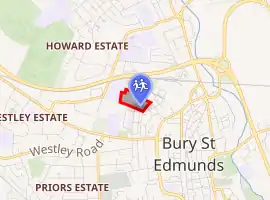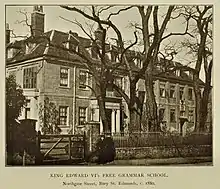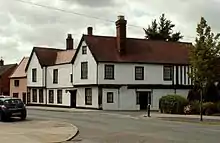King Edward VI School, Bury St Edmunds
King Edward VI School is a co-educational comprehensive secondary school[1] in Bury St Edmunds, Suffolk, England. The school in its present form was created in 1972 by the merging of King Edward VI Grammar School, with the Silver Jubilee Girls School and the Silver Jubilee Boys School. The school occupies the site of the former Silver Jubilee schools in Grove Road Bury St Edmunds.
| King Edward VI Church of England Voluntary Controlled Upper School | |
|---|---|
| Address | |

| |
Grove Road , , IP33 3BH England | |
| Coordinates | 52°15′03″N 0°42′15″E |
| Information | |
| Type | Voluntary controlled school |
| Motto | Schola Buriensis |
| Religious affiliation(s) | Church of England |
| Established | c. 1550 |
| Founder | King Edward VI |
| Local authority | Suffolk |
| Department for Education URN | 124856 Tables |
| Ofsted | Reports |
| Headteacher | Mr Lee Walker |
| Gender | Coeducational |
| Age | 11 to 18 |
| Enrolment | 1,600 (As of Sep.2016) |
| Houses | Kentwell, Ickworth, Wyken, Elveden, Melford, Hengrave |
| Colour(s) | Crimson and Gold |
| Publication | Celebrate! / The Iconoclast |
| Former pupils | Old Burians |
| Website | http://www.king-ed.suffolk.sch.uk |
History

King Edward VI School was founded about 1550 and has occupied a number of sites in the town prior to moving to the current location in 1972. It is believed there was a school in Bury St Edmunds from the 10th century. In 903 the body of King Edmund was laid in the priests' college, of which the school was a part. King Canute established a Benedictine Monastery in Bury, and paid from the royal purse for boys of promise, even freed sons of slaves, to attend school. In 1550 lands were given to provide funds for a "scole ther to be founded by the kinges Maiestie in the like manner as the school at Sherbourne".
King Edward VI School is, therefore, the second King Edward VI School in the country and celebrated the 450th anniversary of its foundation in 2000. Bury was privileged to have a Royal School. The charter with Edward's seal is in the Public Records Office together with documents and books from the early years of the school's existence. One of these is the list of rules for the masters and boys. Originally a grammar school for boys, who studied Greek, Latin and religious instruction, it has moved to various different sites in the town all of which are marked with plaques donated by the Old Burians' Association.[2]
The oldest and most rare of the Grammar School's books and records are now deposited in the Cambridge University Library, including the psalter which had survived from the Abbey of St Edmund. The University Library has a collection of more than 500 books belonging to the school. Some of the books were used by teachers and students - texts in Latin and Greek, stories, the plays of Shakespeare - and some were donated to the school by former students. Some tell the history of the school; one - The English School-Master - was written by former headmaster Edmund Coote and probably led to him losing his job.[3]

Having been a foundation grammar school since its foundation in 1550 the school surrendered some of its independence in 1922 when it became a Direct Grant School meaning an annual grant was paid to the school by the Board of Education for each boy above the preparatory department provided an agreed percentage of free place boys were admitted each year. In 1944 with the enactment of the 1944 Education Act the governors of the school decided that they could no longer meet the financial demand necessary to meet the requirement of the Act in order to maintain charity and thereby Direct Grant status given the requirements for improved facilities for curriculum delivery that the Act demanded. Accordingly, in August 1946 the school became a Voluntary Controlled School under the aegis of the West Suffolk County Council Education Committee.
World War I and World War 2

In common with schools of its type King Edward's has lost many Old Burians in war. Four old boys were killed in the Boer War and 32 in WW1. On 4 February 1921 a memorial bearing the names of 32 old boys killed in the Great War was dedicated in the Cathedral at Bury St Edmunds. Twenty nine old boys gave their lives in WW2 and a memorial those former pupils was place close to the existing WW1 memorial in 1949. Both memorials were designed by Basil Oliver,[4] an old boy of the school.
King Edward VI School Today
The current school remains a Voluntary Controlled Church of England school and accepts Students from ages 11 to 18, it is attended by approximately 1400 pupils. It is a specialist sports college and is a Training school for new teachers. Since 2008, the school has also been partnered with Shanghai Yangjing-Juyan Experimental School in China to develop international links[5] and exchanges between the schools have occurred.[6]
The school was rated "Good" in its 2014 Ofsted Inspection[7] and the school achieved a 77% 9-4 pass rate at GCSE and a 99% pass rate at A Level in 2018.[8]
In September 2016 the school became an 11 to 18 institution admitting pupils in years 7, 8 and 9.
Since September 2011, the school has operated a house system and incorporated vertical tutoring. The school's house system operates through six 'Colleges' [9] which have been developed to create smaller learning communities in which all students can benefit from more opportunities for participation, teamwork and leadership. The Colleges, all named after Suffolk places with significant heritage, are Elveden, Hengrave, Ickworth, Kentwell, Melford and Wyken.
The Old Burians Association
There in an active alumni association known as The Old Burians which was established during the era of the former grammar school and continues to recruit new members from the school. It has existed for at least 200 years, and possibly longer. Re-formed after the Great War in 1922, its fortunes have fluctuated, but it now currently has a worldwide membership of around 600 former pupils and staff. The Old Burians Charitable Trust Set up in 1997 provides financial support to Sixth Formers for personal development projects.[10]
Previous Headmasters
- 1553–c1560 John Fenn (deprived of office)
- c1670 Edward Leedes
- 1788–1809 Michael Thomas Becher
- 1809–1828 Benjamin Heath Malkin
- 1828–1841 John Edwards
- 1841–1855 John William Donaldson
- 1855–1879 Albert Henry Wratislaw
- 1879–1890 Charles Sankey (left to become a House Master at Harrow)
- 1890 - 1894 James Peile
- 1894 - 1908 Arthur Wright Callis
- 1908 - 1911 E T England
- 1911 - 1923 B S Richards
- 1923 - 1940? J M Wadmore
- 1940? - 1970 Robert Elliott
- 1970 - David Pullen
- 1981 - 2002 Michael Moran
- 2002 - 2017 Geoff Barton
- 2017–Present Lee Walker
Notable Old Burians
- John Battely – Archdeacon of Canterbury
- Charles James Blomfield – Bishop of London
- Edward Valentine Blomfield – classicist
- John Burroughs – architect
- Robert Butts – Bishop of Ely
- Thomas Clerke, MP
- Richard Cumberland – dramatist
- Sir Charles Davers, Bt - politician
- Roy Flatt – dean of Argyll and The Isles
- Edward Greene – founder of Greene King brewery
- John Mitchell Kemble – historian
- Basil Charles King FRSE - geologist
- General Charles Lee – general in US Continental Army
- Dudley Long North – politician
- William Sancroft (1617–1693) – 79th Archbishop of Canterbury
- Sir William Spring, Bt – politician
- Stephen Spring Rice - philanthropist
- Sir Thomas Watson, Bt – President of Royal College of Physicians, physician to queen
- John Winthrop the Younger – governor of Connecticut
- Frank Wise - economist and politician; Labour MP, 1929–31
- George Pretyman Tomline - theologian and Bishop of Lincoln
- Edward Romilly - cricketer, MP for Ludlow and Chairman of the Board of Audit
- Edmund Boulnois - businessman and politician
- Thomas Collins (cricketer, born 1841)
- John Walsham - diplomat
- Chris Auchinvole - New Zealand politician
- Mercer Simpson - writer
- Edward FitzGerald - Poet and Translator of Rubáiyát of Khayyám
- Mark Smith (academic) - Vice Chancellor of Lancaster University
- Chris Walker-Hebborn - Commonwealth Games gold medallist swimmer
- Ed Upson - professional footballer
- Jocelyn Pook - musician and composer
- James Poulson - cricketer
- Robert Dewing - cricketer and army officer
- Charlie Carrel - Professional poker player and coach
- Jack Lankester - professional footballer
References
- Education Performance Tables
- "Old Burians Website".
- [King Edward VI School - Bury St Edmunds, Suffolk "KE VI Facebook page"] Check
|url=value (help). 16 June 2016. - Elliott, Robert (1963). The Story of King Edward VI School. Foundation Governors of the School.
- http://king-ed.suffolk.sch.uk/international/index.php
- Chinese students welcome to Bury – Bury Free Press, 8 October 2009
- "Ofsted report Feb 2009". Archived from the original on 15 April 2014. Retrieved 7 October 2011.
- "Examination Results 2018" (PDF). 2018.
- "King Edward VI Website".
- "Old Burians website".
External links
| Wikisource has original text related to this article: |
